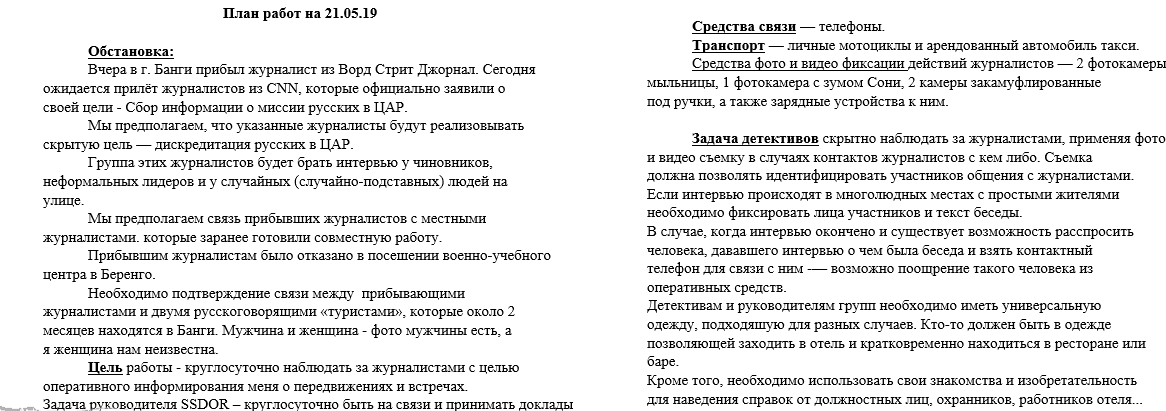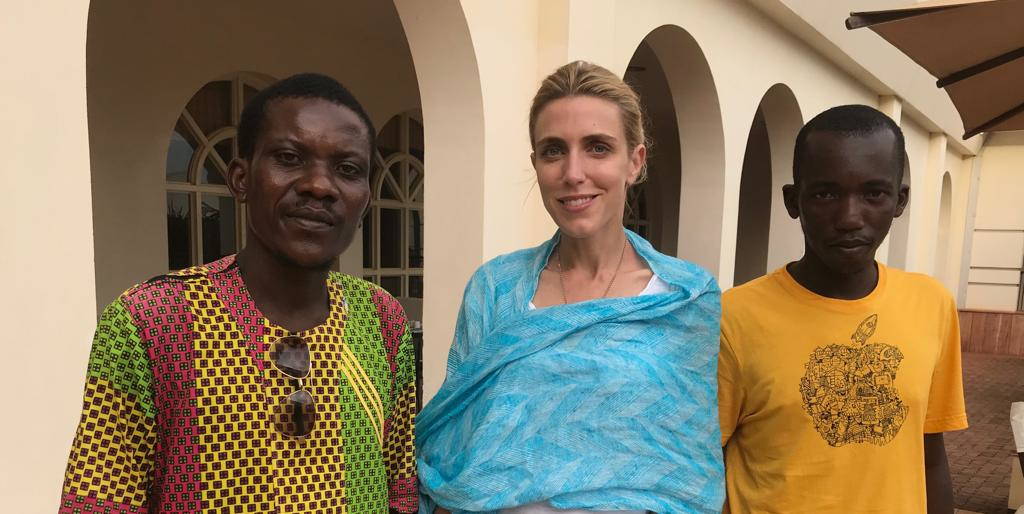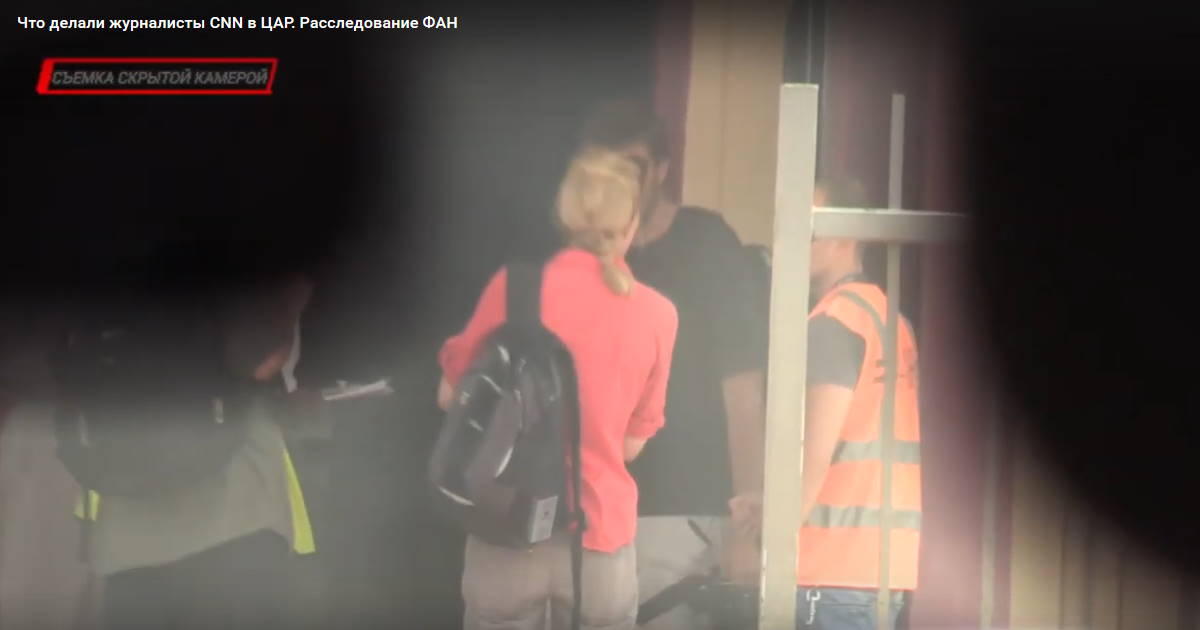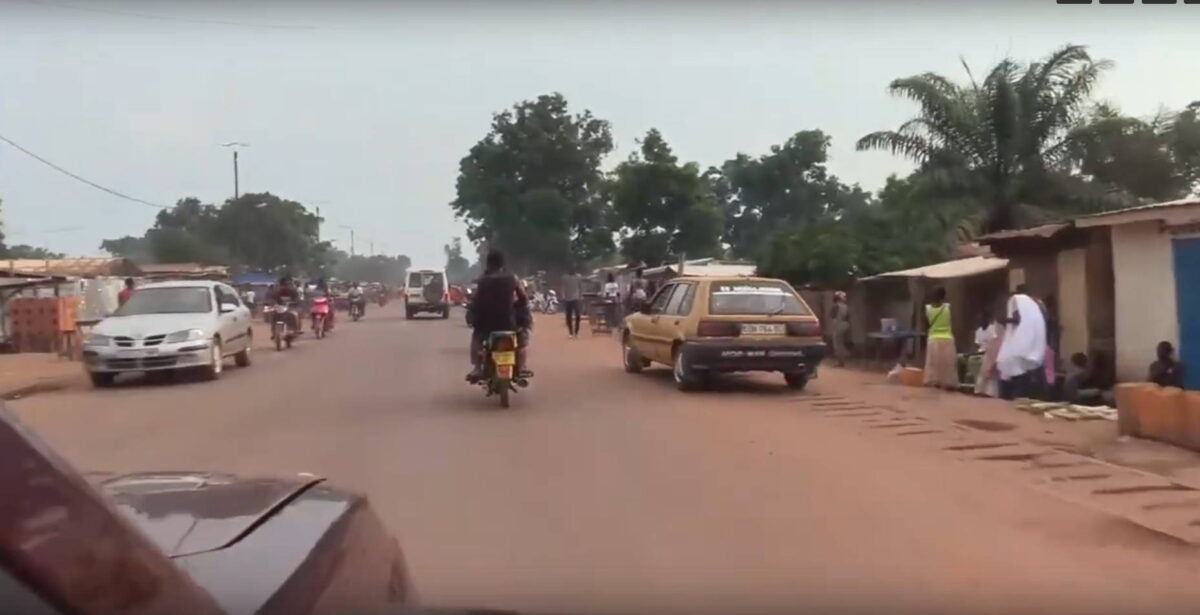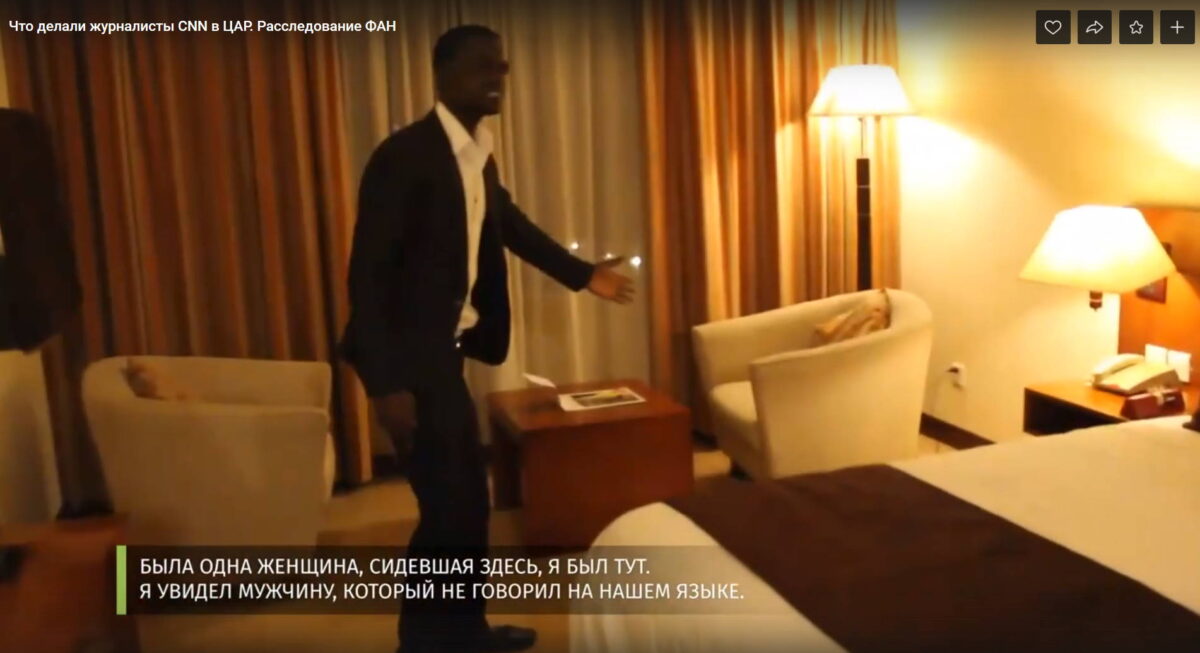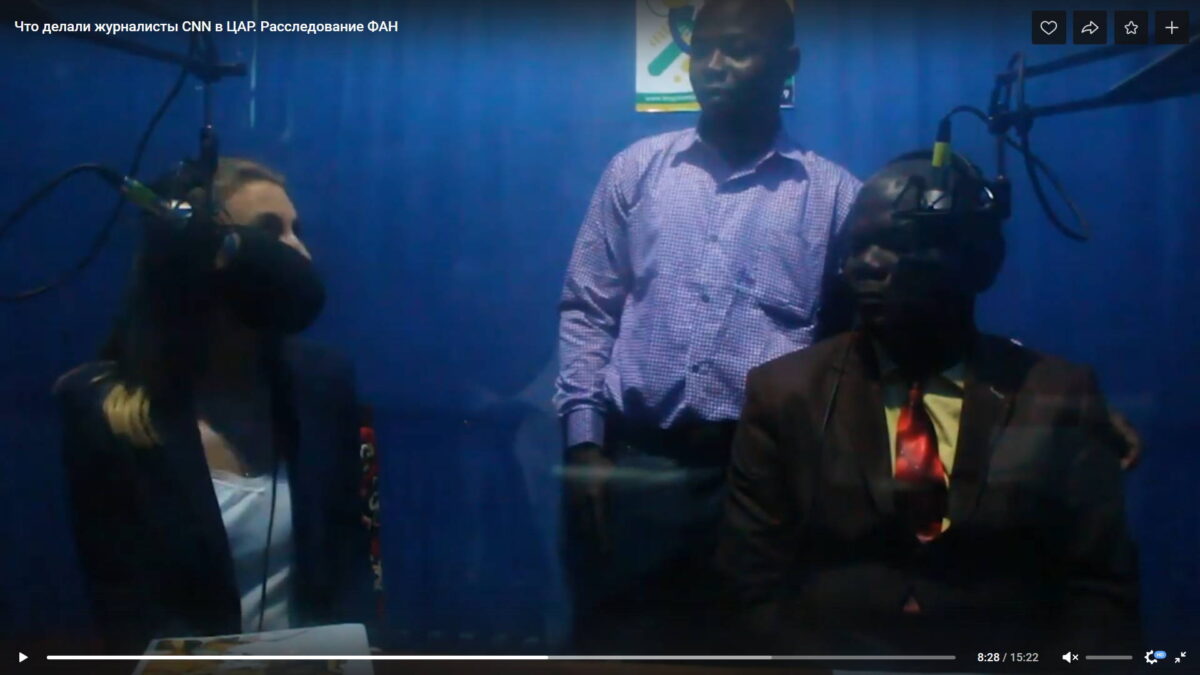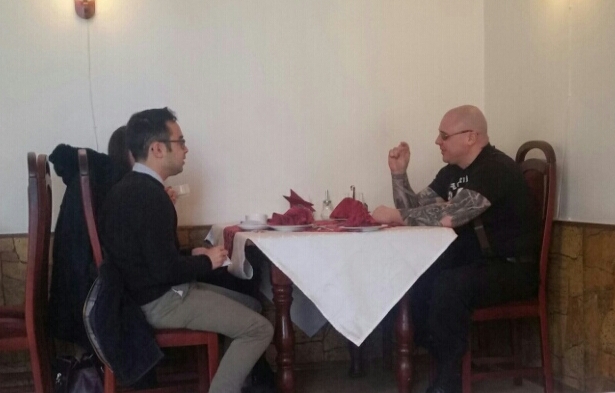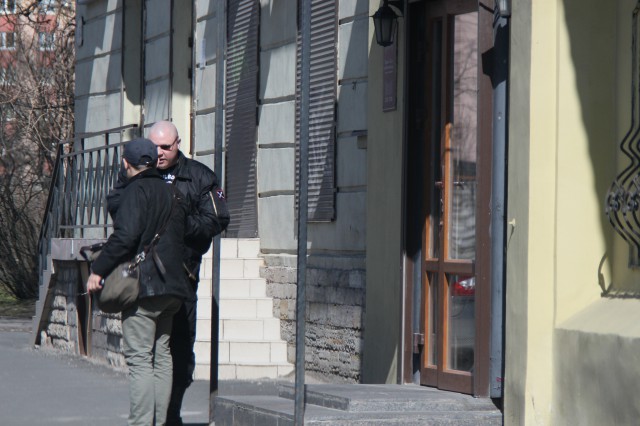Threats, Lies and Videotape: Prigozhin's Long-Running War on Free Media
- In our previous article from this investigation series, we described the origins and the state-run nature of Russia’s shadow military units, known collectively under the name “Wagner PMC” (private military company).
- We also identified the close collaboration between Yevgeny Prigozhin and the highest echelons at the Kremlin, the Ministry of Defense (MoD) and the GRU/GU.
- We disclosed the identity of Col. Konstantin Pikalov, who has spearheaded Russia’s African interventions from a security and military perspective, and has served as a liaison between Prigozhin’s “army of political consultants” and the Russian MoD.
In this installment of our joint investigation with Der Spiegel and The Insider we provide evidence of systemic unlawful surveillance, intimidation and harassment of journalists and bloggers, both in Russia and abroad, conducted by Prigozhin’s security apparatus with the connivance of the Kremlin and/or the direct assistance from Russia’s security services.
The Hit Job on CNN
Bangui, Central African Republic
On 21 May 2019, a team of three CNN journalists and a supporting crew of five landed in Bangui, the capital of the Central African Republic.
Their aim was to report on the seemingly impenetrable interplay between private and public Russian interests in the country.
Russia had begun shipping military trainers to the republic under a UN-approved Russian assistance mandate in early 2018. However, it soon became apparent that 1,500 trainers sent to the CAR were not members of the Russian military but employees of an opaque Russian private military contractor linked to Yevgeny Prigozhin, Sewa Security Services. A short time later, in April 2018, a Russian company affiliated with Prigozhin received gold and diamond mining concessions in the mineral-rich country.
These events had already piqued the interest of three Russian journalists who in July 2018 arrived in the CAR to investigate the role of Russian mercenaries there. On their first day in the country, they had been denied access to the Berengo Palace, the former abode of Emperor Bokassa that had been repurposed by Russian troops into a military base. The following day, a local fixer to whom they had been introduced to by a Prigozhin employee convinced them to head to the town of Bambari, where they believed they would be able to film alleged Russian mining operations.
The three were subsequently killed in an ostensible robbery – in which none of their equipment had been stolen – just outside Sibut on 30 July 2018. Russian and Central African investigations into their death appeared perfunctory and inconclusive, and a detailed independent review by the Dossier Center (an investigative organization funded by the exiled Russian businessman, Mikhail Khodorkovsky, who had also funded the three reporters’ trip to the CAR) found that Prigozhin associates had at least passively contributed to the journalists’ deaths by consciously luring them to a particularly dangerous area of the country. A counter-investigation published by Prigozhin’s own media group, in turn, improbably assigned blame for the murder to Khodorkovsky himself as well as to French intelligence services.

Murder victims Orkhan Dzhemal, Aleksandr Rastorguev, and Kirill Radchenko, Photo: Dossier Center
Almost a year later in May 2019, a CNN reporting team led by the network’s chief international correspondent Clarissa Ward arrived in the CAR to try and make sense of the seemingly impenetrable interplay between private and public Russian interests in the country.
What the CNN team didn’t know as they arrived was that plans had already been put in motion for their surveillance, intimidation, and, ultimately, attempted discrediting.
“Assignment: Surveil 24/7”
On 20 May 2019, an internal, top-secret memo was distributed to a small group of Russian team-leaders in the CAR comprising political strategists, media consultants and private security contractors. The memo, written in Russian with an instruction to have it translated into French “for SSDOR”, laid out the tasks for the following day, 21 May.
(Translation)
Action plan for 21.05.19
Situation:
Yesterday, a journalist from the Word (sic) Street Journal arrived in Bangui. Today, CNN journalists are expected to arrive who have officially announced that their goal is to gather information about the mission of the Russians in the CAR. We assume that these journalists will implement a hidden agenda to discredit the Russians in the Central African Republic.
A group of these journalists will interview officials, informal leaders and random (randomly-planted) people in the street.
We are assuming the incoming journalists are connected to the local journalists who have been preparing their joint work in advance.
The arriving journalists have been denied a visit to the military training facility in Berengo.
It is necessary to confirm the connection between the arriving journalists and two Russian-speaking “tourists”, who have been in Bangui for about 2 months. A male and a female – we have photos of the man, but the woman is unknown to us.
The assignment is to monitor the journalists 24 hours a day, 7 days a week, for the purpose of being promptly informed of their movements and meetings.
The task for the leader of SSDOR is to be constantly in touch and to receive reports from the field in real time, and to provide us with reports on the situation every two hours.
The tasks to be coordinated by Convoy: to implement non-stop undercover surveillance of the journalists and track their visits, and to ensure proper usage of the means for photo and video recording
Means of communication – telephones.
Transport – personal motorcycles and rented taxi vehicle.
Means of photo and video recording of journalists’ actions – 2 soapbox cameras, 1 Sony zoom camera, 2 cameras camouflaged as pens, as well as the chargers for them.
The detectives’ job is to covertly watch the reporters by using photo and video recording whenever journalists are in contact with anyone. The recordings should allow for the identification of participants in communication with journalists.
If interviews take place in crowded places with ordinary people, it is necessary to capture the faces of the participants and the text of the interview. When the interview is over and there is an opportunity, questions must be asked of the person who was interviewed regarding the content of the conversation. Telephone contact details must be taken. It is permissible to motivate the person from operational funds.
Detectives and team leaders need to wear universal clothing suitable for different occasions. Some people must be wearing clothes that allow them to enter the hotel and stay for a short time in a restaurant or a bar.
In addition, you need to use your acquaintances and ingenuity to make inquiries from officials, security guards, hotel staff etc
Note: we obtained a copy of this memo alongside other files that were on a device used by a high-ranking employee of Prigozhin’s Africa-focused project. We have confirmed its authenticity through an interview with a former Prigozhin employee and via matching its content to data that is not publicly known.
We have not been able to establish conclusively what the abbreviation SSDOR stands for. Based on other references seen in leaked correspondence from the African team, it appears to be a local paramilitary force active in the CAR. Judging from the acronym, it may be an affiliate or subsidiary of Sewa Security Services that employs local mercenaries or security staff. Convoy is a reference to the Convoy Military Security Company, a St. Petersburg legal entity managed by Col. Konstantin Pikalov, and likely denotes the Russian mercenaries employed in the CAR through the locally incorporated Sewa Security Services.
On the first day of shooting in Bangui, the CNN team – comprising Sebastian Shukla, Tim Lister and Clarissa Ward – already knew they were being tailed. Their local fixer had spotted the same two men on mopeds near their hotel, which was situated at a vantage point over the city and at the downtown market. After confronting the two men and calling in the police, they sped off. The next day, when CNN approached for an interview Valery Zakharov, the Russian military adviser to the CAR president, he appeared well informed of their movements, including the fact they had taken a trip near his residence earlier that day.
What the CNN team didn’t yet know during these first days was that the seeds were being planted for the later attempt to discredit their mission. A couple of days into their assignment, while Clarissa Ward was working at the hotel, two men appeared and said they were local journalists. They casually asked Ward about her work, her impressions of the country and requested a selfie with her. She politely obliged. A third man also approached the team at the hotel and offered his help with their story. The CNN reporters declined.
After a few days of filming, the CNN team realized they needed more time – and access to more places than could be arranged during the trip, given the bureaucratic delays at every junction – and decided to return to the CAR for follow-up filming a month later, in June. Based on the material filmed during the first visit, the team produced and aired a report on the humanitarian situation in the CAR. As it did not focus on the Russian presence, this report did not lead to any reactions from Russia.
During the second working visit in June – which would result in CNN’s report on the Russian presence – the surveillance and harassment was noticeably stepped up. The man who had earlier offered his unsolicited help was invariably sitting at the hotel lobby, conspicuously taking photographs of Ward. She noticed him away from the hotel too – including bumping into him in a restricted airport area, beyond the security check, as she was making her way to film at the diamond mines near Boda. When the man realized he had been recognized, he quickly vanished.
During the visit to Boda – where a Russian company linked to Prigozhin controls mining operations – the CNN team was also continually hassled on trumped-up pretexts. They were held up by police at the airport for over an hour, under suspicion of “smuggling diamonds”. Once at Boda, the gendarmerie showed up at the hotel and escorted them to the local police station. This time they were accused of faking one of the team’s press accreditations. The team were held at the precinct for over an hour and were only able to get back to the hotel after reaching out to various ministers they had met during their earlier interviews.
On the second day in Boda, the team left early in the morning for the mining area leased out to the Prigozhin-controlled company Lobaye Invest. Once there, they interviewed two teenage artisanal miners who said they were working for Russians. The Russians whom they occasionally meet, they said on camera, come from the military base at Berengo.
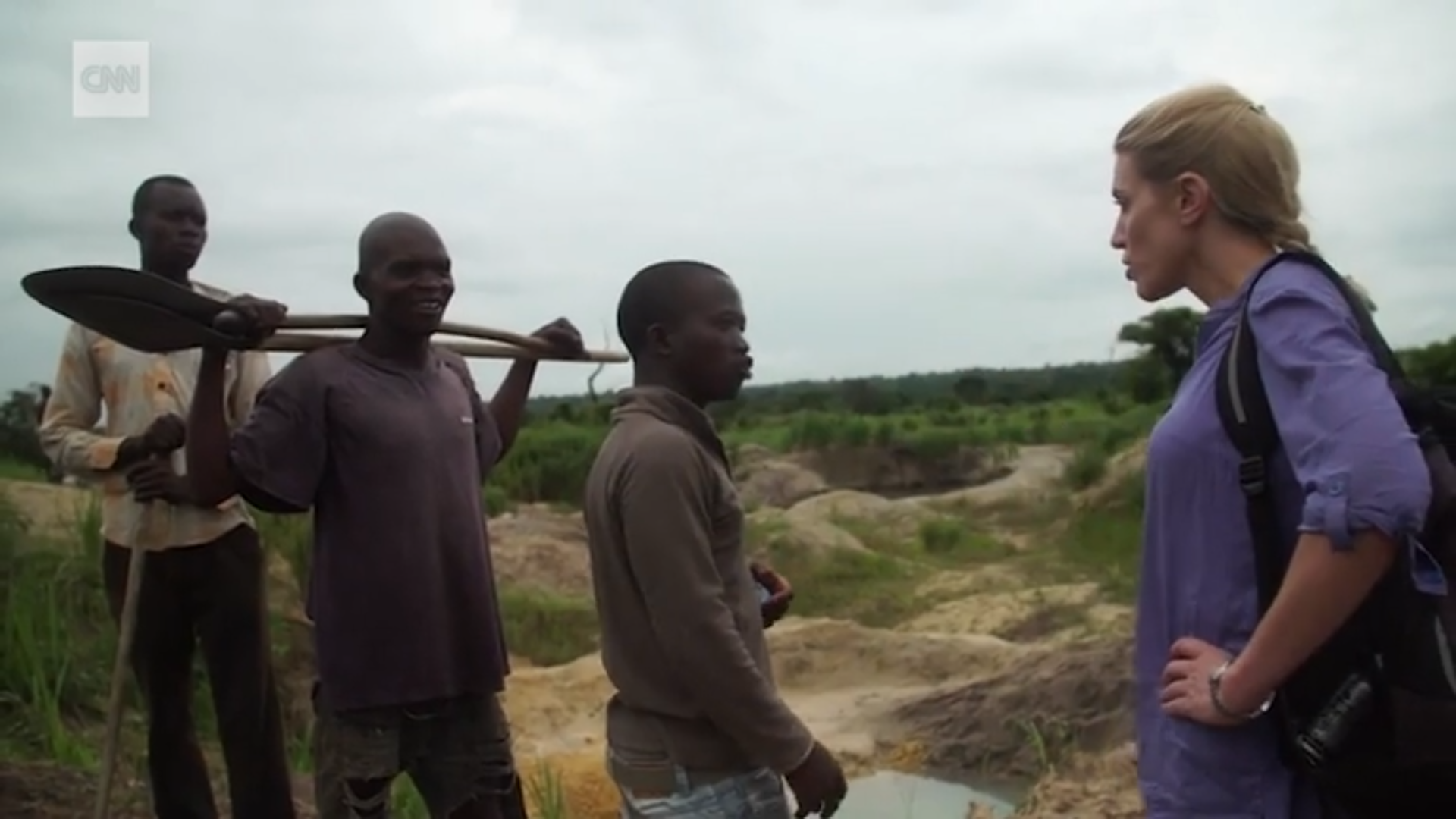
Local miner, Rodriguez, told Clarissa Ward he personally saw Russian visitors to the mine. He said they were from among the military advisers.
On the way back from the mines, the CNN team saw a 4×4 vehicle full of what they described as foreign “white men” waiting on the edge of Boda. They were in the company of one local, who the fixer recognized as one of the two men who tailed the CNN crew on motorbike during their first trip. Ward tried to approach the car and talk to the men, but they drove off at full speed while making sure their faces would not be caught on camera. The same situation occurred a second time at a different place on the way back from the mine to Boda. This time the CNN crew tried to chase the SUV, until realizing they might be purposefully being lured into the wilderness away from the town, and turned around.
Speaking to the mayor of Boda about the incident later that day, he told them that the same car had been spotted near the airport overnight, with the foreigners apparently sleeping in the car. A call to Valery Zakharov informing him of the intimidating encounters yielded a response that “these men are most likely ordinary miners”. The team left town as soon as possible after the incident.
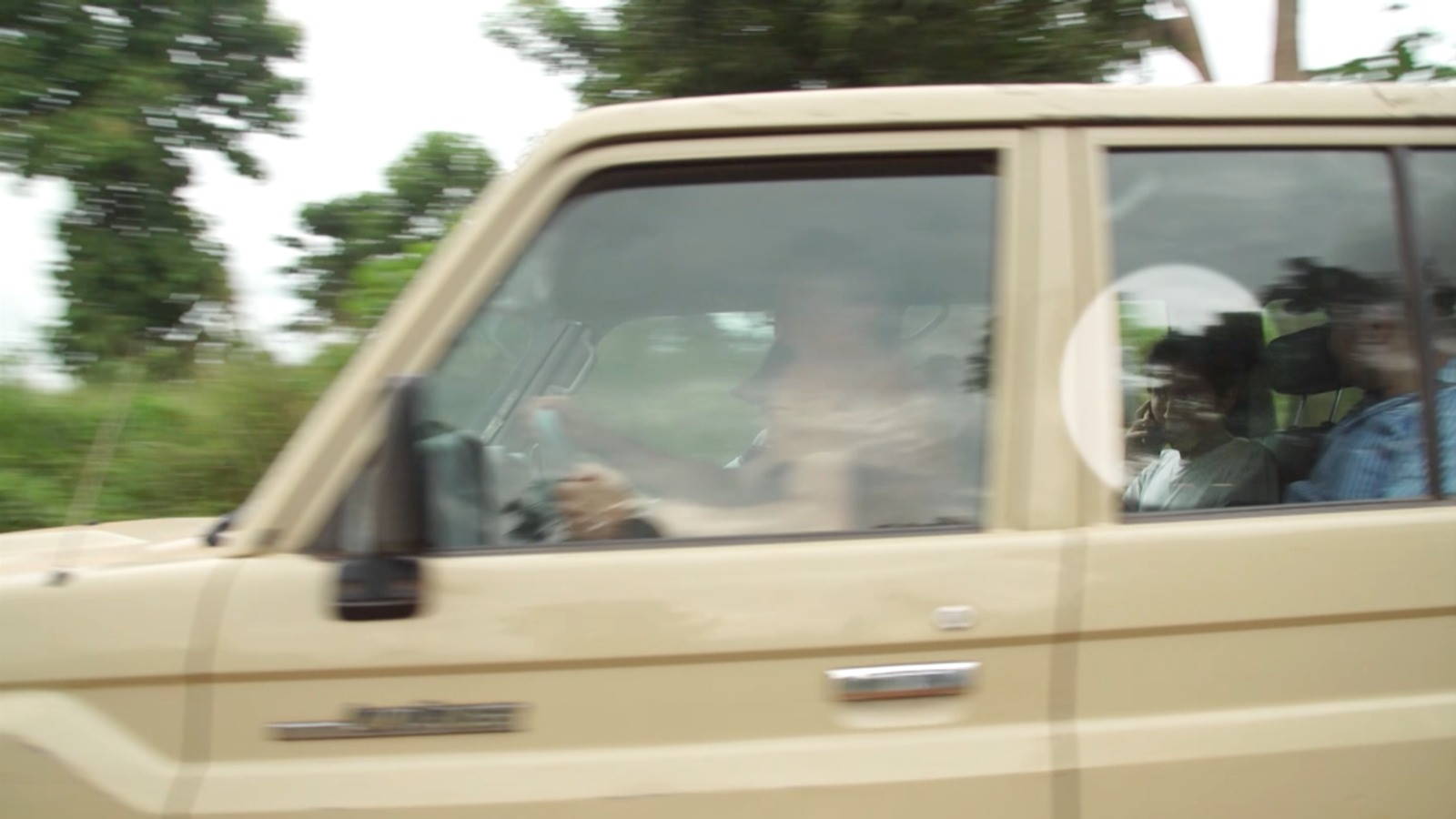
The vehicle with the three men outside Boda. The face of only one of them – talking on the phone – could be captured on camera. Photo Credit: CNN
CNN was able to identify the person talking on the phone in the car as Klim Kasyanov, a translator working for a Prigozhin company. They managed to contact him via social media and confronted him about the encounter, but were not able to elicit any meaningful response from him.
We have independently identified the person in the car as Klim Kasyanov, a St. Petersburg resident born on 28 April 1987. Kasyanov graduated from a French university in 2013 and worked as a language teacher and a media representative for a chain of jewellery stores in St. Petersburg before being recruited by Prigozhin’s group of companies. Shortly after the July 2018 murders of the three Russian journalists in the Central African Republic, he accompanied and translated for a team of reporters primarily from media controlled by Prigozhin during a so-called “fact-finding” trip. We have tried to reach out via social media to Mr. Kasyanov for a right of response but he did not reply by press time.

A 2015 personal ad from Klim Kasyanov offering his services as French language teacher for a fee of 700 RUB ($9 USD) per hour.
Prigozhin’s Pre-Emptive Strike
The CNN team were set to publish their explosive investigation on 13 August 2019. It would include not only footage showing the intermingling of Russian security and business operations in the CAR, but the first ever on-camera interview with a former Wagner mercenary openly admitting the hybrid army works on the Kremlin’s behalf.
However, Prigozhin’s fake-news operation sought to preempt the damaging report. On 11 August, RIA FAN – a St. Petersburg-based “news agency” previously housed in the same building as the Internet Research Agency (“St. Petersburg Troll Factory), controlled by Prigozhin, and sanctioned by the US over its spreading of disinformation, published a 15-minute video segment called a “special investigation into CNN’s activities in the CAR”. The slickly produced video, an attempted character assassination of the CNN journalists, included many spurious claims about the the reporters. These included unsubstantiated allegations about links to US and British special services and to terrorist groups. The video also included multiple examples of the continuous video and photo surveillance that the CNN team had been subjected to during their stay in the CAR – as laid-out in the memo from 20 May.
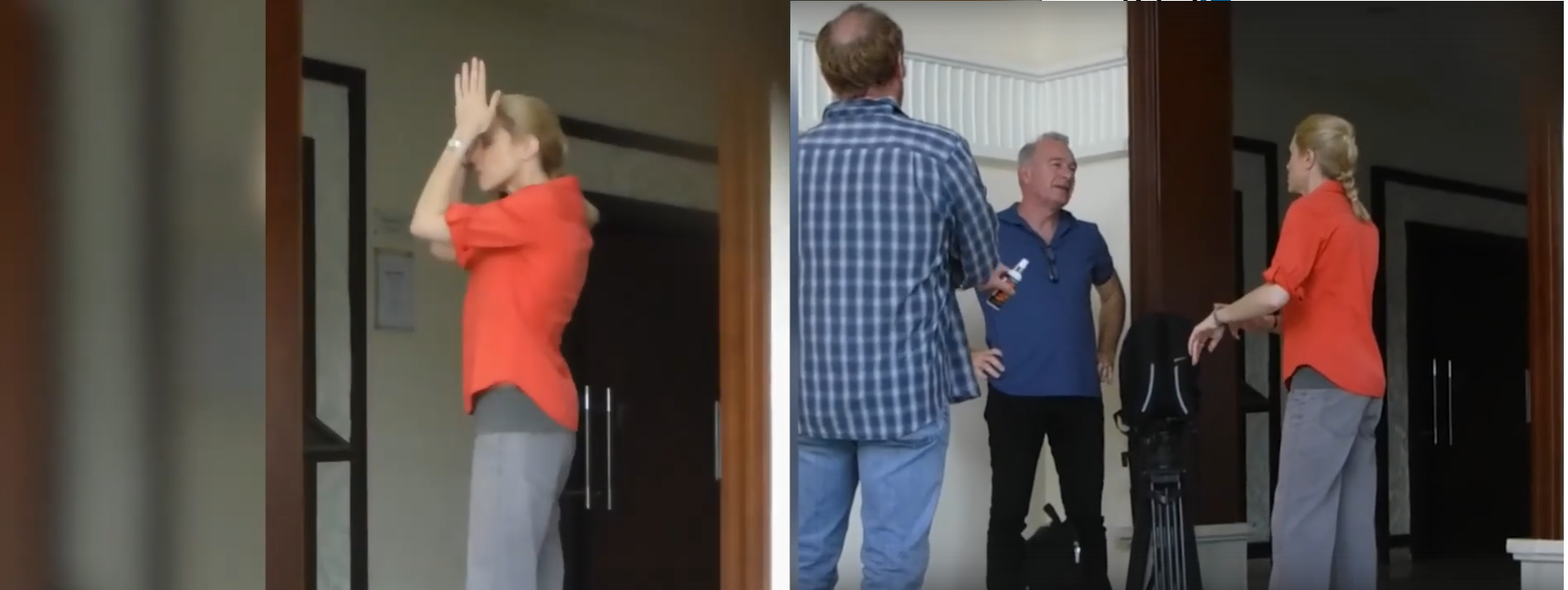
Screen-grabs from FAN’s video showing covert surveillance in Clarissa Ward’s hotel.
The FAN video also cast some of the team’s seemingly innocuous encounters in a much more sinister light. For example, the selfie that Ward had agreed to have taken with the self-styled local journalists had been used to forge a “casting call” poster. FAN, implausibly, was alleging in its video that the CNN team had advertised a casting session for interviewees “with more than 20 local applicants” who were offered cash to lie about their adverse experiences with Russians.
- Selfie with the two men posing as local journalists . Photo Credit: CNN
- One version of the selfie was apparently used to fabricate “casting call” artwork
The video also included a number of other covert recordings of the CNN team at work, many using high-zoom cameras. One segment, disturbingly, showed an interview with a local person inside Clarissa Ward’s hotel room. The person, whom the CNN team does not recognize, claimed he was offered cash by Ward during a casting visit to her room.
- High-zoom covert photograph of Clarissa Ward
- Video surveilance of CNN’s vehicle from another vehicle
- Video from inside Clarissa Ward’s hotel room, likely recorded after she had left
- Unpublished photograph from CNN’s visit to a local radio station
The FAN video went on to show a series of interviews with locals who claim that they were offered cash by the CNN team to badmouth Russians in the CAR – but valiantly refused to do so. The report also made further implausible claims, such as that the CNN team – acting on behalf of the CIA – tried to “establish a network of paid agents within the CAR criminal world” in order to trigger inter-ethnic conflicts at a desired future time.
The video also included an interview with a person who claimed he was an informer for CNN who had been paid to gather negative and false information about the Russian presence in the country. The self-styled informer, who went by the name Iisus May, appeared to be the same person who surreptitiously tailed and photographed Clarissa Ward.
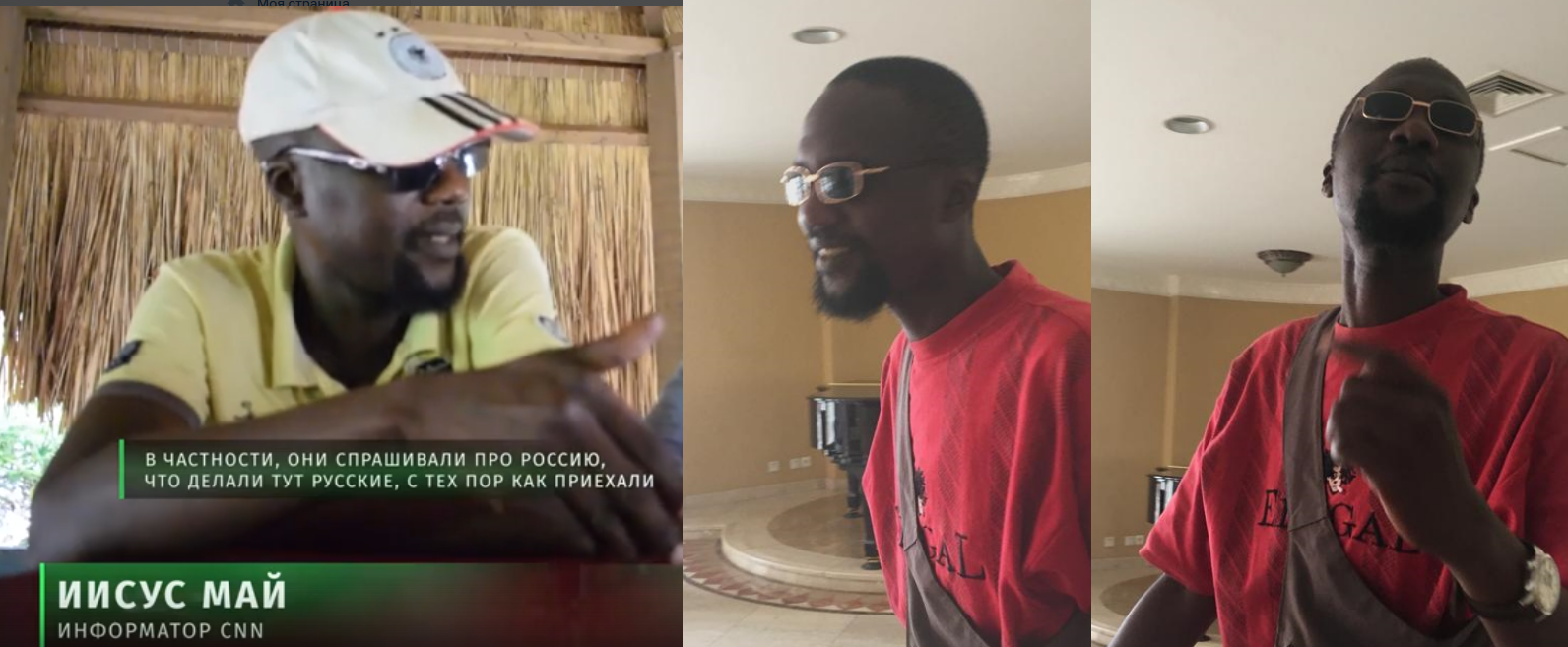
Left, screen-grab from the FAN documentary showing “Iisus May”, self-styled CNN informer. Right, CNN photographs of the man surveiling the team from the hotel lobby. Photo Credit: CNN
The FAN video also included on-camera interviews with the two teenage workers interviewed by Ward at the Prigozhin-controlled mine. They told the FAN interviewers that they had lied to the CNN team, as they had been “bribed with $100”.
The publication by RIA FAN – whose allegations CNN denies entirely – was promptly amplified by the media group controlled by Yevgeny Prigozhin, which is estimated to have the biggest reach of any Russian media, with 33 million monthly readers as estimated in an investigation by the respected business newspaper RBC. It was further amplified through a network of Kremlin-friendly media and hundreds of anonymous troll-bloggers employed by the successor to the Internet Research Agency, the “Lakhta Research Agency”.
Following the publication of the video, RIA FAN published an editorial in which it accused the CNN reporters of making up “fake news” and called upon the network to apologize to Russia over its “Russophobic lies” and to investigate the three journalists over alleged breach of ethical standards. (Shortly after calling out the West’s alleged colonial attitude to Africa, the FAN editorial goes on to say that “the local aborigines will say any nonsense about Russia for a bunch of dollars”.)
Curiously, a teaser version of the so-called investigation, published 3 days prior to the video on RIA FAN’s website, listed an extra name among the CNN journalists who arrived on 21 May 2019 in Bangui. That was Benoit Faucon, who in fact is a journalist writing for the Wall Street Journal. The surveillance memo obtained by us indeed references an unnamed Wall Street Journal reporter, and RIA FAN may have mixed up the two media organizations. Benoit Faucon did in fact co-author an investigation into Russia’s use of mercenaries in the CAR, but in early 2020. It is not clear if he was in the country at the same time as the CNN crew, or that the Russians had received false intelligence. The Wall Street Journal declined to comment for this story.
“No need to panic, Clarissa’
The night after they returned from filming in Boda, the CNN team received a call from the Russian military advisor Valery Zakharov. He offered to take them all out to dinner. The first thing Zakharov said upon greeting his guests, in Russian, was: “You don’t need to panic, Clarissa.” Zakharov was accompanied by only one man other than his translator. This man was tall and muscular, and his role was never explained to the journalists. While it would have been expected for the president’s security adviser to travel with a bodyguard, this man did not quite fit the bill – he was seated next to Clarissa Ward, and was treated by Zakharov with deference atypical to be displayed toward security detail.
Two persons who attended that dinner said that the person who was sat next to Ward strongly resembled the man in the photograph we identified as Konstantin Pikalov – the liaison between Russia’s Ministry of Defense and Prigozhin’s political, media, and mining operations in Africa.
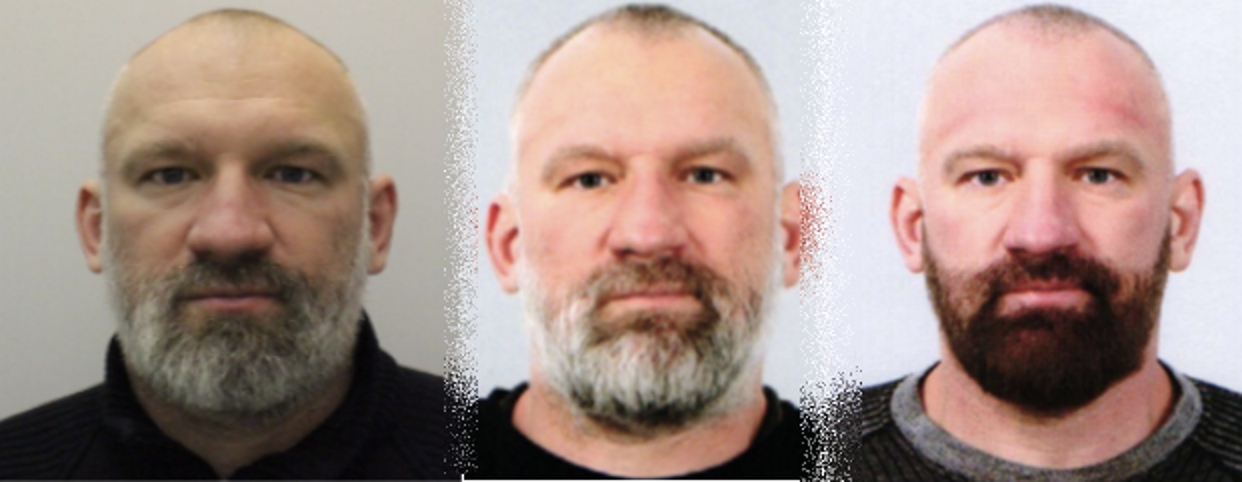
Col. Pikalov’s visa application photographs from different periods – the latest one showing apparent coloring of his beard and hair to make him appear younger. People working with him in the CAR – and people attending the dinner with CNN – recognized him from this last photo.
According to email correspondence from Prigozhin’s employees seen by us, Col. Konstantin Pikalov – who at the dinner intended to give the CNN journalists reassurance that they were not being tailed – was the author of the very surveillance memo targeting the CNN team.
A History of Surveillance and Intimidation
There’s little doubt that the surveillance, intimidation and defamation campaign against CNN in the CAR could not have been executed by Yevgeny Prigozhin’s private organization without the collaboration of the Russian state via its official military presence in the Central African Republic. The operation required collaboration from local law-enforcement, access to the airport’s secure area, as well as access to intelligence information that could only be available to a state party. Correspondence obtained by the Dossier Center in the course of their investigation of the Russian journalists’ July 2018 murder showed the close coordination between Prigozhin and the official Russian mission in the CAR.
However, the active measure employed against CNN follow a long-established modus operandi used by Prigozhin’s private operations against journalists whom he perceives as threats to his – and the Kremlin’s – interests. In most cases, this M.O. uses a combination of unlawful surveillance, private intimidation, public discrediting and endangerment via the spreading of false information that might make the journalist a target of attacks by third parties.
The hacked email correspondence of Prigozhin’s security service leaked in 2015 disclosed many of the surveillance and intimidation methods used by his group. The mail archive shows continuous procurement of surveillance equipment – including cameras disguised as pens, clothes buttons, coat-hangers and and lighters.

Two items procured by Prigozhin’s security department: surveillance cameras camouflaged as a lighter and as a coat-hanger
The hacked emails also show blood-curdling evidence of actual surveillance of independent reporters. Journalists tailed and surreptitiously photographed or videotaped included authors from Novaya Gazeta, Dozhd TV, Forbes, and other independent media. Targets included both journalists who had shown an active interest in investigating Prigozhin’s own business dealings and those who were simply deemed as anti-Kremlin. In one case, we discovered a full report on all journalists working for Novaya Gazeta, including photographs and vacation schedules. The correspondence also includes fully developed plans to use legal ploys to shut down inconvenient media.

Sequence of surveillance photos of a leading independent journalist, discovered in the email of Prigozhin’s security staff. Many other examples of surveillance were discovered among the leaked emails.
In addition to surveillance and smear campaigns, media investigations have linked Prigozhin to potentially more serious acts against journalists and bloggers. A December 2018 joint investigation between Novaya Gazeta and the OCCRP focused on the confessions of an alleged former security operative for Prigozhin’s organization. This operative shared with journalists stories of harassment and spying, poisonings, physical harm visited upon one independent blogger who had tweeted a cartoon disparaging Putin, and the alleged murder of another blogger by poisoning. Novaya Gazeta reporters were able to validate at least some of the former security officer’s confessions, including through finding in his phone surveillance photos of the first blogger who was severely beaten, and who ultimately stopped blogging.
The reporters were also able to tentatively validate Prigozhin’s security team’s involvement in the poisoning of another blogger from Pskov, near the Estonian border. This relatively low-key blogger, Sergey Tikhonov, who frequently ridiculed Russian foreign and domestic policies, and whose home Prigozhin’s ex officer was able to describe with meticulous detail, officially died of a heart attack in June 2016. His blog, still available online, bears the ominous motto: “If we can speak truth only in whispers, that means the country has been captured by the enemies”. The blogger’s death was never investigated.
Going Global
While most of Prigozhin’s targets have been Russian journalists and media, the attack on CNN is not the first time his organization has used intimidation and fabrication to try and discredit international media. In April 2015, an American journalist, Adrian Chen, traveled to St. Petersburg for the New York Times to write an exposé on the Prigozhin-funded Internet Research Agency. During his stay Chen conducted many interviews, including with former employees of the troll-farm, some of whom had all too willingly agreed to talk to him.
One day after he left St. Petersburg, on April 29 2015, FAN – the same news agency that would later produce the fabricated documentary attacking CNN – published an article with the headline “What Does a New York Times Journalist Have in Common With a Nazi From St. Petersburg?” The article detailed a meeting between Chen and a St. Petersburg neo-Nazi. Its feature image was of a skinhead giving an enthusiastic Nazi salute. That same skinhead had been brought to a restaurant as “security” by one of Chen’s interviewees – who claimed he was her brother. Instead, he was in fact a notorious local neo-Nazi from the Totenkopf group, Alexei Maximov, who spent nine years in prison for murder. The article claimed the meeting was set up by the New York Times in order to “create a provocation against Russia” by inciting neo-Nazis to revolt against the Kremlin. The story also tied Maximov – who was obviously acting on Prigozhin’s bidding in this set-up – to Ukraine’s far-right. The article included covert photographs of the restaurant interview settings, using an angle that showed only Chen and the neo-Nazi, and omitting the actual interviewee.
(The FAN article subsequently removed the photographs, we are posting them below from an archived version of the site.)
After the initial FAN publication, and almost identically to the CNN case four years later, the fake story circulated among a smaller network of Prigozhin-affiliated media, and many more blogs of untraceable provenance. Similarly to the CNN dissemination, each new repost – especially in the trollosphere – added more and more bizarre – and dangerous – false details to the story, including claims that Chen was working for the CIA and the NSA. A slick video also appeared on YouTube (now suspended by Google) that included covert footage of Chen leaving his hotel room.
Also identically to the CNN case, the avalanche of forgeries was launched by Prigozhin’s organization preemptively, in an attempt to discredit a pending investigation before it is published.
Attacking Bellingcat
Ironically, while Bellingcat and its partner media were working on this current series of investigations into Prigozhin, we became the object of a preemptive attack which was nearly identical to that levied against CNN, and earlier, against Adrian Chen with the New York Times.
The attack began after our lead investigator approached several current and former employees of Prigozhin’s African operations as well as of Project Translator: Prigozhin’s new and upgraded version of the US interference project tested during the 2016 elections. Using direct messages via WhatsApp and social media, our team went through standard right-of-reply procedures and informed these people that their names had come up in employee lists for the respective Prigozhin project and offered them the opportunity to confirm, deny, or provide their point of view.
Initially, none of the people we messaged reacted. However, on the second day one of them – Emmanuel Asamoah, an African student residing in St. Petersburg and, according to corporate payroll data seen by us, worked for the US-focused Translator Project in 2019 – responded and requested a voice call. In the call he claimed that he had only worked for Prigozhin (which he alleged he didn’t even realize) on a single project, translating a book from Russian into English. Then, he said he was in dire financial need and asked our investigator for any paying assignment or job. Our investigator told him this was not appropriate or feasible.
Several days after this phone call, RIA FAN published a series of fabricated text and voice messages, allegedly from Bellingcat employees or affiliated journalists.
In particular, RIA FAN fabricated Russian-language messages from Bellingcat researcher Pieter van Huis (who at the time was not even involved with the investigation into Prigozhin) that appeared to be sent from three platforms: Twitter, Facebook, and WhatsApp. Apart from the fact that none of these were in reality sent, there were a number of logistical issues with the fabricated screenshots and messages, including the character spacing on the Twitter direct messages being too condensed for the (allegedly used) iPhone Twitter app, the fact that “Pieter” misspells his own name in Russian (the crude, to a Russian ear, “ван Хьюис” rather than the more acceptable “ван Гюйс”, which Pieter used in a previous report), and the illogical choice for the Dutch “Pieter” to use a Belgian number in the WhatsApp messages. RIA FAN also, inexplicably, blurred the phone number from which the alleged messages were sent – making a rebuttal based on actual phone ownership impossible.
Additionally, RIA FAN published audio messages from an alleged WhatsApp “voice chat” between a self-styled “journalist from Bellingcat” and a RIA FAN employee. For some reason, this other “journalist” (who, per RIA FAN, was different from “Pieter”) had the exact same Belgian number as “Pieter”, as the visible +32 46 prefix and the remaining blurred digits appear identical in both screenshots. These audio messages contain the voice of what is clearly not a native Russian speaker, with varying levels (sometimes within the same clip) of grammatical and phonetic proficiency. The voice does not match that of any Bellingcat researcher, especially not of those who can speak even a minimum amount of Russian.
After Bellingcat published the first part of its investigation into Prigozhin’s operations, RIA FAN doubled down on its attempt to discredit us. It published freshly-forged direct messages, in which it made it appear – like in the case with CNN – that Bellingcat was offering cash to RIA FAN employees for adverse information. In this case, Prigozhin’s operation used as a template for their forgery an existing WhatsApp message offering a right-of-reply to Ms. Irina Zyuskina, a person who – according to payroll data seen by us – has worked for the US-focused disinformation project Translator. The forged version of the message removed the name of Project Translator and replaced it with RIA FAN, and added non-existing controversial content.
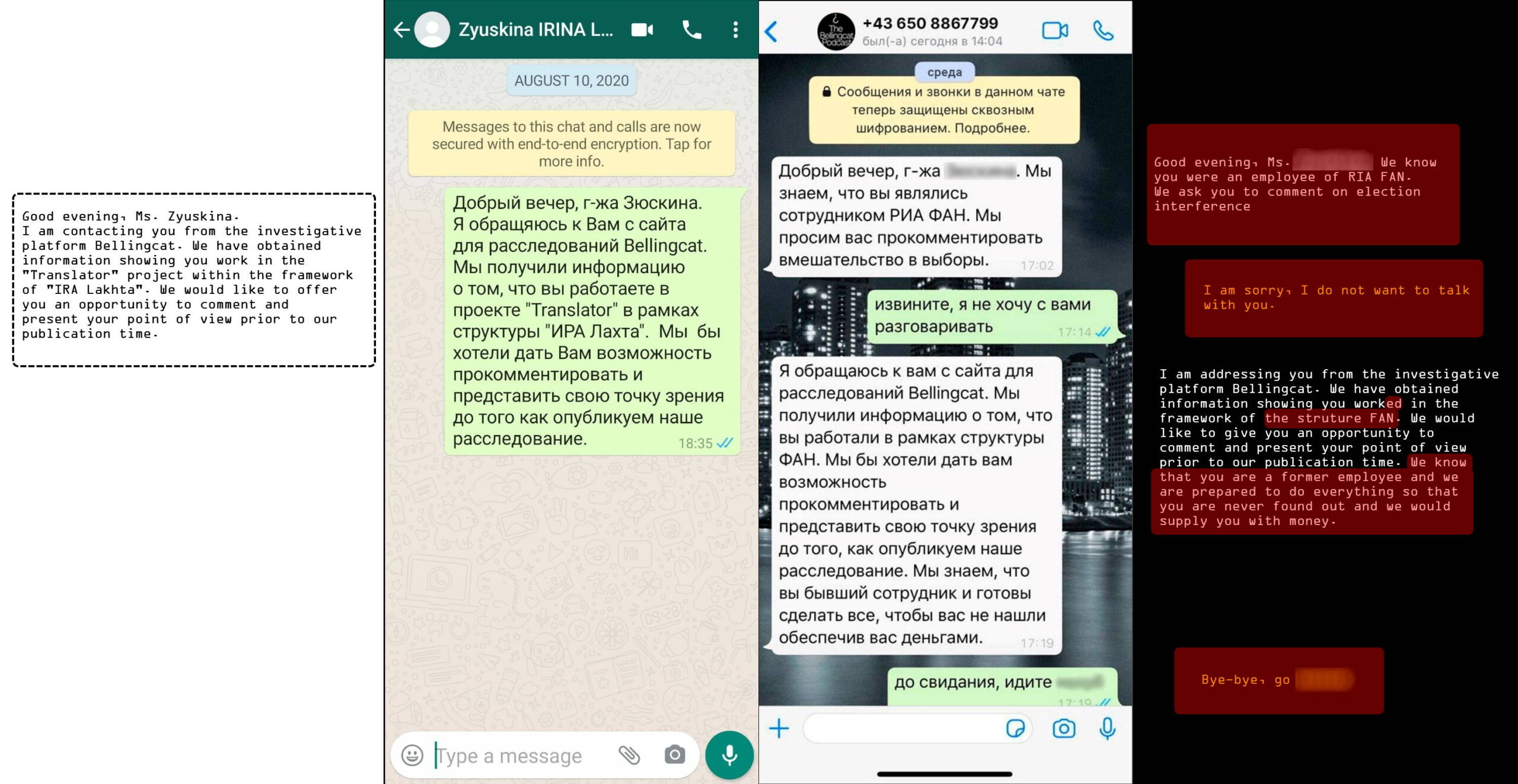
Click image to view in full size. Left half: actual WhatsApp message from Bellingcat’s phone number, including translation. Right half: a fabricated chat. All added or modified content is shaded in red.
Just as with the incidents with CNN and Adrian Chen, a network of troll factory-affiliated sites, accounts, and other pro-Kremlin or nationalist media — by our count, over two hundred within a week of RIA FAN’s publication — launched a blitz of amplification of these false allegations. These included accusations of “Pieter” offering bribes and threatening the contacts with retaliation through Western security services. In an unprecedented escalation, Yevgeny Prigozhin spoke up in-person, accusing Bellingcat of falsely claiming the Internet Research Agency exists, and threatening legal action “in Russia and in the United States”. In a further escalation, RIA FAN and one of Prigozhin’s highest-profile employees, Aleksandr Malkevich, publicly requested Russian politicians take legal action against Bellingcat and Russian journalists cooperating with us. RIA FAN even published a black-list of names of such alleged Russian collaborators, despite the fact that only a small part of the list indeed ever cooperated with Bellingcat.
Despite the demonstrably false allegations produced by Prigozhin’s operations, Russian establishment politicians, including ruling party MPs, joined Prigozhin’s chorus and suggested legal measures must be taken against Bellingcat. These false allegations were even amplified by Russia’s deputy ambassador to the United Nations, and further by the official Twitter account of the Russian Ministry of Foreign Affairs.
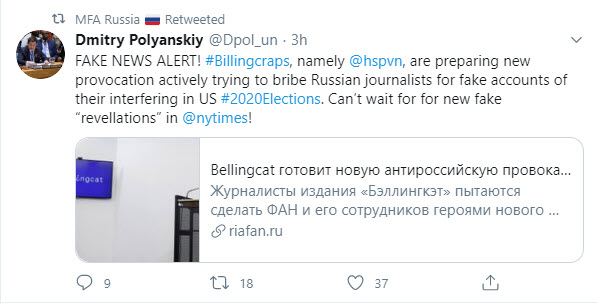
Given the apparent symbiotic, synchronized echo-chamber between Prigozhin’s fake-news operations and the Russian government, the Kremlin’s attempt to disown his interference operations as a private initiative appear as implausible as its attempts to distance itself from Wagner’s overseas interventions. The political choice has apparently been made that Yevgeny Prigozhin is indispensable for the Kremlin’s hybrid warfare, in the truest sense of the phrase with both information-space campaigns and actual military operations.
Whether Russia’s civil society is willing to to wager its country’s reputation in the long term by linking it inextricably to that of an ex-convict who runs semi-covert military operations, mass-manufactures demonstrably fake information, and surreptitiously surveils, intimidates, and exposes journalists to danger, remains to be seen.
In the next and last installment from this three-part investigative series, we look at Prigozhin’s history of obsession with the United States, the evolution of his interference efforts in American politics, and his plans for influencing operations in the upcoming 2020 elections.
